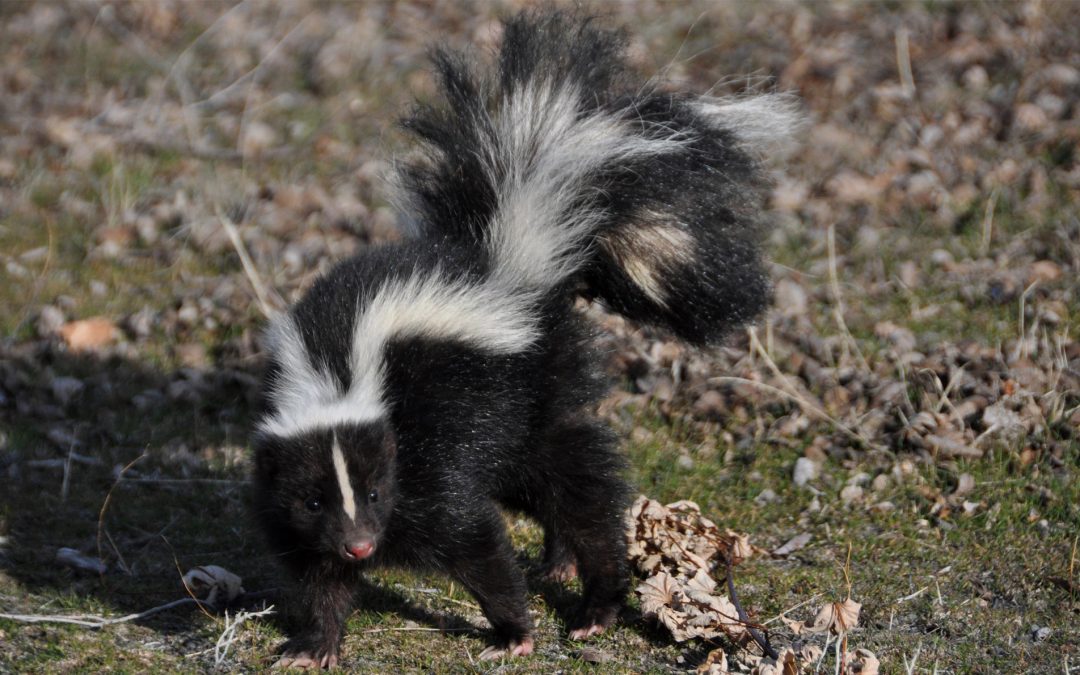A colleague of mine recently said that she had submitted a series of skunks that she killed in her horse barn to the lab and every single one of them tested positive for rabies. In fact, she says, she’s never submitted a skunk that didn’t test positive. As livestock producers who interface with wild and domestic animals as a matter of routine, you and your family are at particular risk. It is important that you know some basic information about rabies in animals to protect your family and animals.
Rabies is distributed widely in the United States, with only Hawaii considered free of the virus. Most island states and nations have been able to attain free status by eradication of infected animals, testing of all incoming animals, and vaccination. Their natural water barrier provides biosecurity from uninvited animal guests. For those of us surrounded by land, rabies virus will always be a reality via animal migration.
All mammals are capable of infection with the rabies virus. Rabies is rare in very small mammals, like rats and squirrels, whereas raccoons, foxes, skunks and other wild mammals serve as major reservoirs of the virus. These reservoirs maintain the virus in animal populations and are often the source of infection for livestock and other domestic animals. Infection of dogs and cats often occurs from fighting with reservoir wildlife, while horses, cattle, and other livestock are likely to be bitten on the muzzle, udder, or feet when encountering wildlife.
Saliva is the body fluid we all associate with rabies transmission, but spinal fluid, respiratory mucus and milk may also contain the virus. A bite is the most direct way to have a viral exposure, but because respiratory droplets may contain the virus, simply being in the presence of a rabid animal can be infective. This type of exposure can occur when entering caves inhabited by rabid bats.
The location on the body where initial infection occurs matters concerning the disease course. If the initial exposure is through a bite, let’s say, the biting animal’s saliva will be present in that wound. The virus then latches onto the nerves in that area and move via ‘retrograde axonal transport’ headed for the brain. This means that the virus travels backwards up the nerve headed back to that nerve’s source, the brain. The virus travels at a pretty steady rate. So, for the animal bitten on the muzzle, the virus is going to get to the brain quickly and clinical signs will start relatively quickly after the bite. For a cow bitten on the back foot, that virus has a long way to go to get to the brain so there will be a delay before the disease is noticed. This is important to know because, in the case of the hind foot exposure, that length of time may be long enough for the initial bite to be healed over and no longer noticeable. Therefore, not finding a bit wound on an animal suspected of having rabies should absolutely not be used as criteria to say that the disease can’t be rabies.
There is no ‘typical’ set of signs of rabies. It can literally look like anything. I and my colleagues have seen rabies in cattle present as everything from a single limb lameness to overt seizures. Any signs that appear to be neurologic in origin and any changes in behavior should incite consideration of rabies. There are three distinct syndromes described for rabies, but there is no way to define all the potential ways in which rabies can present. In the furious form of rabies – think Old Yeller – animals are very excitable, easily startled, and show rage. They may also strain as if constipated and act as if they are choking. Never stick your unprotected hand into the mouth of any animal that appears to be choking. This is where the ‘afraid of water’ traditional belief comes from. These animals are unable to swallow and therefore drool and are averse to attempting to eat or drink. Finally, some of these animals may bellow relentlessly, with cows often sounding like bulls. In the dumb form of rabies, reported to be most common in cattle, animals are often profoundly depressed and do not eat. This is in total contrast to the furious form that we all envision – dumb form animals are extremely passive and it’s easy not to think of rabies in this way. In the paralytic form, animals may be lame or unable to maintain proper placement and motion of their limbs.
Rabies can only be definitively diagnosed in veterinary species by postmortem exam or necropsy. The brain is removed and submitted a specialized diagnostic laboratory for testing. When an animal is suspected to have rabies, it should only be handled by a veterinarian and only a veterinarian should remove the brain. Most veterinarians are vaccinated against rabies as part of our routine preventative health care due to our high risk of exposure. For this reason, in addition to taking proper precautions when handling the body, we have an extra layer of protection through vaccination.
Several years ago, I was called to look at a stocker calf with neurologic signs. He was down, had odd behavior, and appeared to be blind. There are several more common causes of those symptoms in a calf that age, but the list always has to include rabies. I treated the animal for a more common disease and told the owner that rabies could be a possibility. I recommended that no one handle the calf, specifically to not handle the head, where exposure through saliva could easily happen. A couple of days later, I got a call that the calf had died and the owners were concerned because the husband had handled the calf’s head, got saliva and mucus on his jeans, and came home. When he walked in the house, their toddler children come running up and hugged his legs. A truly frightening situation. At that point, I told them to immediately contact their physician, whose job it is to determine the level of risk and an appropriate plan of action. Members of the family were ruled to have had high risk of exposure and underwent post-exposure prophylaxis, the series of injections given to prevent the disease after exposure. These are expensive, painful, and must be started soon after exposure to be effective. Suffice it to say, it is preferable to avoid this situation altogether by taking great care when handling animals suspected to have the disease.
Anytime you have an animal with a change in behavior or the appearance of neurologic disease, rabies has to be considered. If you must handle these animals, latex gloves or palpation sleeves should be worn to protect your skin from exposure. Most of us who work on farms and ranches have cuts on our hands all the time, making us particularly vulnerable to the virus entering our skin. Have a veterinarian evaluate the animal and determine the proper course of treatment if another disease is suspected or a testing plan if rabies is a high concern. There is no treatment for rabies in animals.
Finally, get your animals vaccinated against rabies. For dogs, cats (yes, especially barn cats), and horses should always be vaccinated. Discuss vaccination of other species like sheep, goats, pigs, cattle, llamas, and alpacas with your veterinarian. This disease is not to be trifled with and is not a place to cut corners on our preventative medicine costs.

